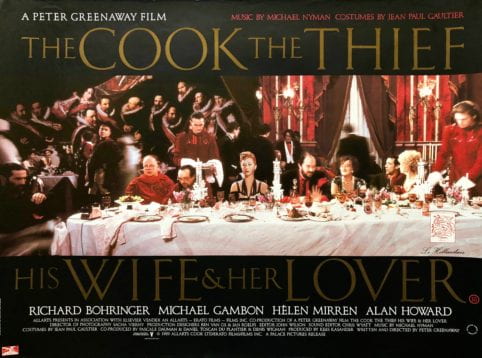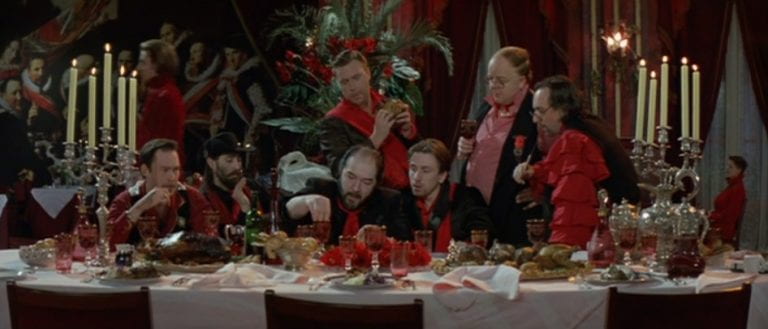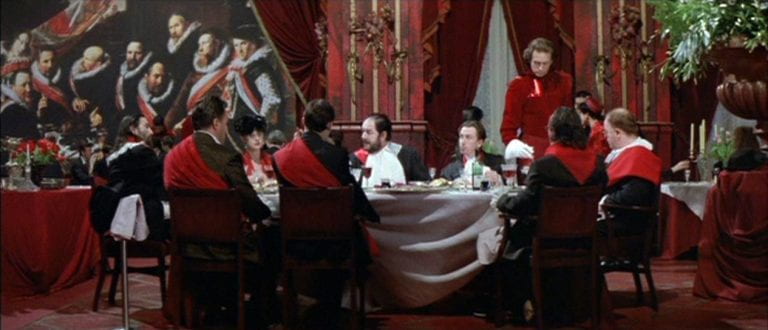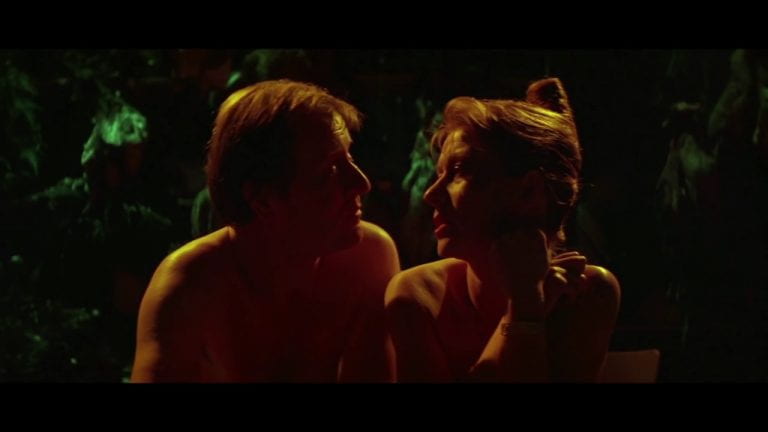
The Cook, The Thief, His Wife and Her Lover poster
Recently, I posted my thoughts on the movie “The Platform”, a movie which I watched as my thoughts turned to the rich experience of food at Thanksgiving. The movie is visually beautiful, managing to be both Brutalist in its sets, while a meticulously set table of a sumptuous feast is shown descending, to be ravaged and destroyed, color filtered through a washed out palette that renders its splendor null and void, draining it’s vitality as it heads into decay. The Platform is also a horror, and horror requires something that perhaps brings up the bile in our throats, and what better statement to make about food as a symbol of Power, the inequities of this world, vice, transformation and survival than cannibalism?
Immediately upon seeing the opulently prepared food, knowing it would be rendered into refuse as the story progressed, I was reminded of a long-time favorite of mine, the Peter Greenaway film, “The Cook, The Thief, His Wife and Her Lover” (1989). As a person with a deeply ingrained appreciation for the pleasures of food, not only for nourishment and enjoyment of it, but as a rich and sumptuous visual metaphor, this movie fed my art-house cravings.
Synopsis –
Albert Spica (Michael Gambon) is an imposing criminal boss, who has decided he will shine his patronage upon his favorite restaurant, Le Hollandais. We are introduced in a scene in which we see a man debased and beaten, ending in scatalogical humiliation. Spica has elbowed his way to part “ownership”, prepared from the start of the film to bully his way to the forefront, each night bringing in his crew of henchmen and his long-suffering and traumatized wife Georgina (Helen Mirren) into the restaurant where he can openly display his brash and uncultured tastes at the dinner table as lavish feasts are presented for his consumption by the Cook, Richard Boarst (Richard Bohringer). Georgina herself seems to bear herself with elegance and a nuanced taste that goes undeserved by her husband, who constantly abuses and terrorizes her.
Georgina finds herself distracted by a genteel man in the restaurant, who spends his time engrossed with reading as he enjoys his meal. Michael (Alan Howard) is a bookstore owner, and he is equally drawn to Georgina. Somehow, they manage to meet and boldly begin an affair that is witnessed, aided and abetted by the restaurant staff and owner who are not enamoured of her cruel husband. This, needless to say, does not go well, and the resulting wrath from Spica that we bear witness to is horrific and violent as Michael is forcibly stuffed with the pages of his own beloved books.
Georgina has had it. In a Shakespearian turn, her revenge is poetic and symbolic – Chef is convinced by Georgina to prepare her lover’s remains as the main course of a feast to be presented to her husband. The final act of revenge is most decidedly NOT served cold, as she forces Spica to eat the flesh of Michael, before ending him with a bullet to the skull.

In the Kitchen
Semiotics of the Sublime and the Grotesque within –
It is a visually stunning work, a breathtaking collage of the sublime and the vulgar, technicolor and jewel-toned, and richly layered in visual references to Baroque art throughout (particularly Flemish Baroque painting). His painterly eye is unsurprising, given that Greenaway was a painter before he was a filmmaker. The underlying theme of succulence and utter ripeness at the border of decay runs throughout this film – Alton Brown, a fan of this film, speaks on the theme throughout – “You’ll notice something in a lot of Peter Greenaway films and most absolutely in this one; the food is both appealing and slightly repulsive at the same time. No other filmmaker is so good at capturing the succulence and kind of decomposition of food at the same time, as though this stuff is just this close to drawing flies.” It speaks to the vulgarity of such bountiful experience, wasted in the hands of brutish thugs such as The Thief, and to how his show of power over his domain and all that have the misfortune to be imposed upon by his demands will be crushed by his inherent corruption. Even the costuming in this movie creates luscious color cues throughout, via the efforts of the avant-garde designer Jean Paul Gauthier.
The filming style utilizes a deliciously rich presentation set much like a stage set, utilizing the fine tradition of “tableaux vivant” as used in theater, in which the scene is displayed as though it were a living painting, yet another nod to his art school history. Scenes often flow one to another by panning laterally, mimicking how we take in the landscapes of huge paintings as well.
The central theme of food is a subject of earthly needs and desires, but also of excess and greed. Sensuality can be found in finely presented feasts, and sexual drives are aligned with the need to be fed an most basic urges, a thought so inelegantly expressed by Spica himself as he states “The naughty bits and the dirty bits are so close together that it just goes to show how eating and sex are related”. The affair and the meeting of sweating, naked flesh occurs in uncomfortable proximity to the food that will be used by the kitchen – the storeroom full of cured meats and bins of uncovered food is notable, and creates a feeling that the lovers themselves are, in this moment, the feast. Interlaced with images of knives reducing food to component parts, focus on the shapes of food that are meant to mimic genitals and set a threatening aura that highlights the danger and the urgency of their trysts. All the while, the rich and saturated use of color spills everywhere.
Color in this film is bright and primal, overwhelming at times. Color is wielded with boldness by Greenaway, often signifying change and the process of transformation. Reds fill entire scenes top to bottom in the dining room, verdant green as we enter the kitchen provides a cooler counterpoint, like a contrast of blood against the forest floor after a hunt; the storeroom, which is utilized throughout, which is where we see the development of their relationship, the nudity and intimacy, reminds us a bit of a lush garden harvest, vibrant and lush in its green background. This green remains even when the scene shifts to other storage in the restaurant, as though the lovers carry that brightness of love and life with them. There is the stark and sterile white to startle us, in the bathroom (note the costumes also change color in all of these scene changes).
Spica’s wrath brings forth the literal spoils of his war – the lovers flee the Garden of their delight, escaping to the garish and anatomical display of a truck full of meats, garbage and rot, their paradise ruined.

Go for Baroque
They hide for a time in the bookstore, which Georgina cannot fathom. “What good are all these books to you? You can’t eat them.”. Food is desire; how can he remain enthralled by something so ethereal? Yet books are symbolic of intellect, a facet of self that Spica has no hope of owning. He uses this symbol so dear to The Lover to extinguish his life; it is appropriate that it is food, the symbol of his carnality literally embodied by that same Lover, that is a participant in Spica’s undoing.
That final act of somber and ritualized cannibalism brings a justice to this demon of a man as he is condemned. Cannibalism is a symbol that hits us in the gut – meant to create revulsion at the taboo of such transgression, horror at such an act that renders what was once human into fodder to be devoured and defecated, an ultimate dehumanization. Yet it is poetic that this is Spica’s downfall, as such a man who holds himself in high esteem is forced to debase himself in such a manner that he must consume the flesh of his own kind, like a starving dog. It is even more poetic as we consider Spica had indeed threatened to not only kill Michael, but to eat him – “I’ll kill him and I’ll eat him!”…Spica is literally being made to eat his words, a tidy mirror image to the cause of the Lover’s demise, eating words against his will. Georgina has tried valiantly to not allow her husband’s corruption within her, but it is clear some has seeped down into her – “…you vowed you would eat him. Now, eat him.” further encouraging him “Try the cock, Albert. It’s a delicacy and you know where it’s been”. He does as he is forced, and with that act, he is ended as she simply says “Cannibal.” His former boast has become his shameful condemnation.
Commentary on Society –
Greenaway has a love of criticisms of culture and societal structure. Spica is a cruel and distasteful vulgarian, created to be despised and destroyed. Georgina simply is a person who may have found the joys in pleasures of daily living – food in particular is a sustaining pleasure to her, and sex gives her some escape from the trauma of her marriage, yet it is fitting that she transforms into a being who brings forth justice in her revenge – we are grateful for her snapping point after witnessing such suffering. We recognize the rich table set before such metaphorical swine as Spica and his thrall as symbolic of those in power who revel in the spoils they steal from the commoner, while enjoying the debasement of those that they exploit and violate, laughing all the while. There is gratification in watching the corrupt be called to justice, and in watching their destruction. Truthfully, a part of each of us would likely gladly extract our pound of flesh from these monstrosities, given a chance, and reclaim some of what we have had stolen from us, while returning the gift of suffering such men in power dispense to all below their station, to remind us who is in charge.
The Cook, The Thief, His Wife and Her Lover is a metaphorical spectacle of violence and a lavish feast of the small tidbits of beauty that we steal back in the grotesqueries of societal power imbalance, fanning hope and displaying the horror of our base nature all at once. Like flies drawn to sup on a boar awaiting the oven, we are repulsed even as we are hungry for the table we set for ourselves, waiting for our turn in the hierarchy of our society to have a taste of that power for ourselves.

Enjoy it while it lasts

I watched this film when it was first released and was so drawn in. Greenaway is one of my favorites and I always find myself in a position of attraction/repulsion with much of his work. This film is a good example of that and your writing now explains why. Thank you for this!